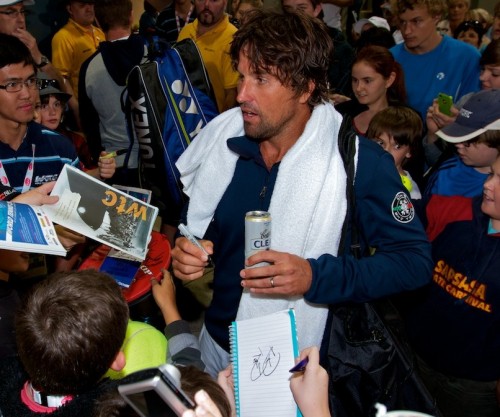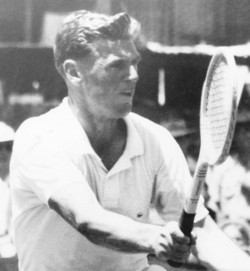
RICHARD LLEWELYN EVANS is a SJA member who moved to Adelaide two years ago. In January this year the freelance sports journalist wrote and published Australia’s first tennis fanzine. The lessons learned were immense
Australia in the new year has become a regular, if unlikely, must-do for John McEnroe. The three Januarys past, McEnroe has headed deep and south to play in Adelaide, the green city by the desert.
The annual World Tennis Challenge, or WTC, is a recent concept, cobbled together by local tennis royalty, Mark Woodforde, Darren Cahill and Roger Rasheed. Adelaide was only settled in 1836 but had run a hardcourt championship since 1880 until it was controversially shifted east in 2009. WTC was their riposte.
Held the week preceding the Australian Open, the WTC is an eight-man hybrid, golden oldies and current players under floodlights, Mac and Pat Rafter the greying stars this year, Alexandr Dolgopolov and Michael Llodra amid the youth.
The format is simple. Three days, two blue, plexicushion courts, side by side, used concurrently. The historic Memorial Drive the host. It’s four teams of two men, singles and doubles. Plus the joker in the pack, the perennial Mansour Bahrami.
Confused? It wasn’t only Mac who didn’t know what he was getting with the WTC. He hated the noise and distraction, then reasoned that as a New Yorker, he should be above all that. Now they can’t keep him away.
The idea for a fanzine arose through failure to find a workable tournament programme.
I’d long pestered the chief exec, Ali MacDonald, to allow me to produce an official tournament programme but cash was short and projected production, design and and printing costs were substantial.
I knew, anyway, that I didn’t want a standard tournament glossy and the idea for the fanzine came through a desire to be less restricted editorially, plus crucially, the reduction in costs it brought.
I decided to fund it myself. In return the WTC gave me free use of all player and venue photographs and access to players and officials. The deal was that once I’d recouped my costs and a decent set limit above, I’d share any profits with the WTC.
In many ways the biggest hurdle was to convince the WTC to go ahead. The CEO’s sole objection was that he didn’t want me to lose money and this was helped by a deal with the printers in exchange for corporate hospitality (the WTC bore this cost, a huge bonus) and by not using a professional design agency. Design quotes were running to $12,000, about £7,500.
I approached the University of South Australia to see whether any masters degree design students might be interested in helping out. In return I paid them (a fair wad but substantially less than an agency charge) and they had a physical product to use towards course marking.
As it turned out, the students, Josh Osis and Lauren Lepore, were a find in a million.

They knew nothing of fanzines (there’s no Australian culture of sports fanzines save for a few failed Aussie Rules versions in the mid ’90s) but took my ideas on board wonderfully. I wanted a homemade, homegrown feel. We used 100gsm paper weighting and produced it on an off white, recycled paper, to give a glued together, run off the photocopier feel.
I decided the editorial content for every page and they came up with the look, handwritten headlines a dominant feature, and it was brilliant.
The cover was easy. Few bridge sport and society like Mac. It had to be him.
And I knew I had to speak to Frank. Frank Sedgman is a regular WTC visitor, attending a charity lunch during the tournament hosted by the son of his former doubles partner, Ken McGregor. Frank sums up everything good about sport.
I didn’t know the 84-year-old Grand Slam legend and caution, shamefully, got the better of me as I bought a plane ticket to his Melbourne home.
Editorially, I’d framed much around the nostalgia of Memorial Drive and Frank was the key interviewee. I wasn’t sure a telephone chat would work.
Once I’d forked out on the flight, I rang to confirm my arrival. “It’s a long way to come,” he said with the great gusto. “I’m very happy to meet you, but could we avoid Wednesdays as it’s when I play golf.”
While the penny dropped immediately that my outlay was unnecessary and reckless, it was the best $400 ever spent.
When I arrived, Frank had dug out a thick folder of newspaper clippings stretching back 65 years or so. We chatted for hours, Frank and his wonderful wife, Jean, answered everything.
It broke the ice for me too with Paul McNamee, Pat Rafter and Tennis Australia chairman, Steve Healy.
Elsewhere Brad Gilbert was a particularly good interviewee, convivial, chilled and a cricket lover. And Brian Clough fan too.
Mac was the only player I couldn’t get, so I wrote a piece about NYC in the 1970s, his origins. It’s difficult to write much original on McEnroe but the angle was different and the nature of the fanzine allowed it to work.
Back to the pragmatics. I got on the phone, tapping contacts to sell advertising and the WTC helped here too. This wasn’t as hard as expected, the real difficulty was selling blind, with no product to show.
I’ll do another WTC fanzine next January but with extra pages, solely for advertising revenue. The simple lesson learned was that advertising, way more than sales, brings in the money.
We sold the fanzines, via commission only sellers, on the gate during the tournament and online at a 10 per cent discount.
I also gave 400 copies, one to every attendee, at the Ken McGregor Foundation charity lunch. Lunch guests included players, business leaders, politicians and the Governor of South Australia. A welcome lever when it comes to the next bout of selling.
Total sales, including the lunch copies, were more than 2,000. The cover price though, I got wrong. At $7, more than £4, it was a giveaway, but in hindsight the psychology of a single $5 note would have worked far better.
It irked that customers shell out repeatedly on beer and food but can query the worth of a lot of work and a damned good buy. But it’s business. Gratingly, I dropped the price to $5 midway through the final night. And it worked.
Overall, a first rate, if time-consuming, venture. The editorial, with some irony, was the easy bit, an add on almost and straightforward throughout.
The chance to plan and write without constraint was priceless. To not just promote but entertain and inform. When I asked Darren Cahill for a pic to accompany his piece, he emailed me a belter of him and Andre Agassi walking off court post-training. So Darren has heroes too and a brief but telling insight into one of the great coaches.
The next step will define my fanzine future. The 2013 WTC version will be bigger and sold better. There is a market away from the mainstream and really it’s where the reader wants to be, clean but edgy, and cool. Short articles, high quality.
A quarterly, non tournament specific, online version is on the cards. It would be good to replicate the hard copy elsewhere too.
The bottom line? Yes, I recouped my costs and came away with a small profit. Just. But it didn’t include my time, which was immense.
But I know Pat Rafter now and he knows me. Brad Gilbert too, Darren, Woody and more. And Mac? Who knows, but it’s a start.
- You can contact Richard at rich@tennisface.tv
- And his fanzine can be viewed by clicking here.
UPCOMING SJA EVENTS
Thu May 10: SJA Ladbrokes Lunch with former England cricket captain Alec Stewart. Click here for booking details.